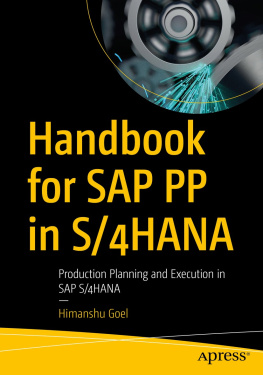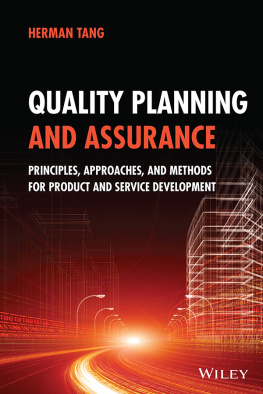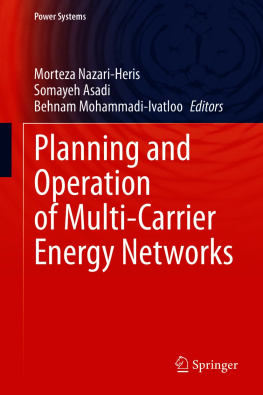Manufacturing Execution Systems
About the Editor
Heiko Meyer has over 10 years of professional experience in developing software solutions for process and factory automation. He holds a master of science degree in mechanical engineering and a Ph.D. in computer science (modeling distributed systems) from the Technical University of Munich (Germany). At present he is head of the research and development department at Gefasoft AG. He has published over 30 papers and several books on the subject of industrial software solutions. He can be reached at heiko.meyer@gefasoft.de.
About the Contributing Authors
Franz Fuchs studied communications and electrical engineering at the University of Cooperative Education in Klagenfurt (Austria). He then worked on several projects relating to automation technology in the automotive industry. In 1984 he and two others founded Gefasoft AG (formerly GmbH). Since that time he has been a member of the executive board of Gefasoft and, among other duties, has been responsible for the basic concepts and designs of Gefasofts MES solutions. He can be reached at franz.fuchs@gefasoft.de.
During the last 40 years, Klaus Thiel has worked as a consultant and project manager for several companies involved in the optimization and rationalization of the manufacturing process. He holds a master of science degree in economics from the University of Munich (Germany). In 1977 he founded Partplan GmbH. The main focuses of this company were consulting in the manufacturing environment and the development of software-based human-machine interfaces. Since 2004 he has worked as an independent production management consultant. He can be reached at info@mes-consult.de.
Manufacturing Execution Systems
Optimal Design, Planning, and Deployment
Heiko Meyer Editor
Franz Fuchs Contributing Author
Klaus Thiel Contributing Author


Copyright 2009 by The McGraw-Hill Companies, Inc. All rights reserved. Except as permitted under the United States Copyright Act of 1976, no part of this publication may be reproduced or distributed in any form or by any means, or stored in a database or retrieval system, without the prior written permission of the publisher.
ISBN: 978-0-07-162602-6
MHID: 0-07-162602-6
The material in this eBook also appears in the print version of this title: ISBN: 978-0-07-162383-4, MHID: 0-07-162383-3.
All trademarks are trademarks of their respective owners. Rather than put a trademark symbol after every occurrence of a trademarked name, we use names in an editorial fashion only, and to the benefit of the trademark owner, with no intention of infringement of the trademark. Where such designations appear in this book, they have been printed with initial caps.
McGraw-Hill eBooks are available at special quantity discounts to use as premiums and sales promotions, or for use in corporate training programs. To contact a representative please visit the Contact Us page at www.mhprofessional.com .
Information contained in this work has been obtained by The McGraw-Hill Companies, Inc. (McGraw-Hill) from sources believed to be reliable. However, neither McGraw-Hill nor its authors guarantee the accuracy or completeness of any information published herein, and neither McGraw-Hill nor its authors shall be responsible for any errors, omissions, or damages arising out of use of this information. This work is published with the understanding that McGraw-Hill and its authors are supplying information but are not attempting to render engineering or other professional services. If such services are required, the assistance of an appropriate professional should be sought.
TERMS OF USE
This is a copyrighted work and The McGraw-Hill Companies, Inc. (McGraw-Hill) and its licensors reserve all rights in and to the work. Use of this work is subject to these terms. Except as permitted under the Copyright Act of 1976 and the right to store and retrieve one copy of the work, you may not decompile, disassemble, reverse engineer, reproduce, modify, create derivative works based upon, transmit, distribute, disseminate, sell, publish or sublicense the work or any part of it without McGraw-Hills prior consent. You may use the work for your own noncommercial and personal use; any other use of the work is strictly prohibited. Your right to use the work may be terminated if you fail to comply with these terms.
THE WORK IS PROVIDED AS IS. McGRAW-HILL AND ITS LICENSORS MAKE NO GUARANTEES OR WARRANTIES AS TO THE ACCURACY, ADEQUACY OR COMPLETENESS OF OR RESULTS TO BE OBTAINED FROM USING THE WORK, INCLUDING ANY INFORMATION THAT CAN BE ACCESSED THROUGH THE WORK VIA HYPERLINK OR OTHERWISE, AND EXPRESSLY DISCLAIM ANY WARRANTY, EXPRESS OR IMPLIED, INCLUDING BUT NOT LIMITED TO IMPLIED WARRANTIES OF MERCHANTABILITY OR FITNESS FOR A PARTICULAR PURPOSE. McGraw-Hill and its licensors do not warrant or guarantee that the functions contained in the work will meet your requirements or that its operation will be uninterrupted or error free. Neither McGraw-Hill nor its licensors shall be liable to you or anyone else for any inaccuracy, error or omission, regardless of cause, in the work or for any damages resulting therefrom. McGraw-Hill has no responsibility for the content of any information accessed through the work. Under no circumstances shall McGraw-Hill and/or its licensors be liable for any indirect, incidental, special, punitive, consequential or similar damages that result from the use of or inability to use the work, even if any of them has been advised of the possibility of such damages. This limitation of liability shall apply to any claim or cause whatsoever whether such claim or cause arises in contract, tort or otherwise.
This book is dedicated to my father
Dr. Karlhorst Meyer,
former professor in the Department of Mathematics,
College of Liberal Arts and Sciences,
University of Florida, Gainesville
HM
Contents
Foreword
When a general business concept becomes absorbed into the mainstream, it sometimes loses some of the sharpness associated with its original formulation. This is a charge that may be leveled with some justification against enterprise resource planning (ERP). On the one hand, an ERP system promisesby the force of its titleto link the entire enterprise together in a comprehensive resource plan. However, ERP systems in real life are far less ambitious. They are equivalent to software to automate a firms accounting and administrative systems. This narrowness of outlook has greatly hindered the vital overlap between a firms ERP system and the system governing the automation of its production planning and execution functions. The latter system is the firms manufacturing execution system (MES). The aim of the current book is to spell out in detail the design of an MES. Along the way, the tricky question of how the ERP system should interface with the MES is clearly answered.
This book is the clearest exposition I have seen of the ideal anatomy of a production-oriented IT system. The fundamentals of product mapping, operations sequence planning, and production control with material management, data management, maintenance management, and quality management are lucidly explained. The authors take great care to avoid clouding concepts with unnecessary jargon: every piece of terminology is carefully and precisely defined before it is put to use.
Next page









